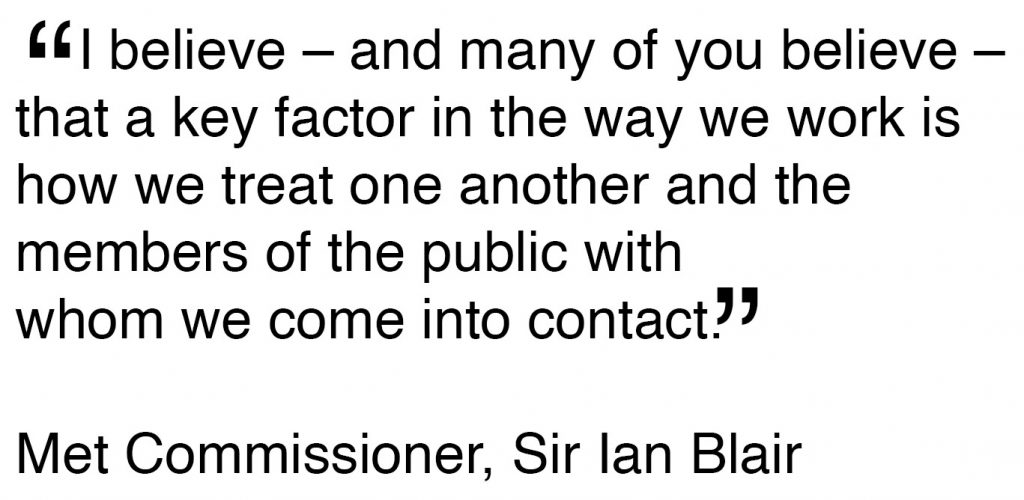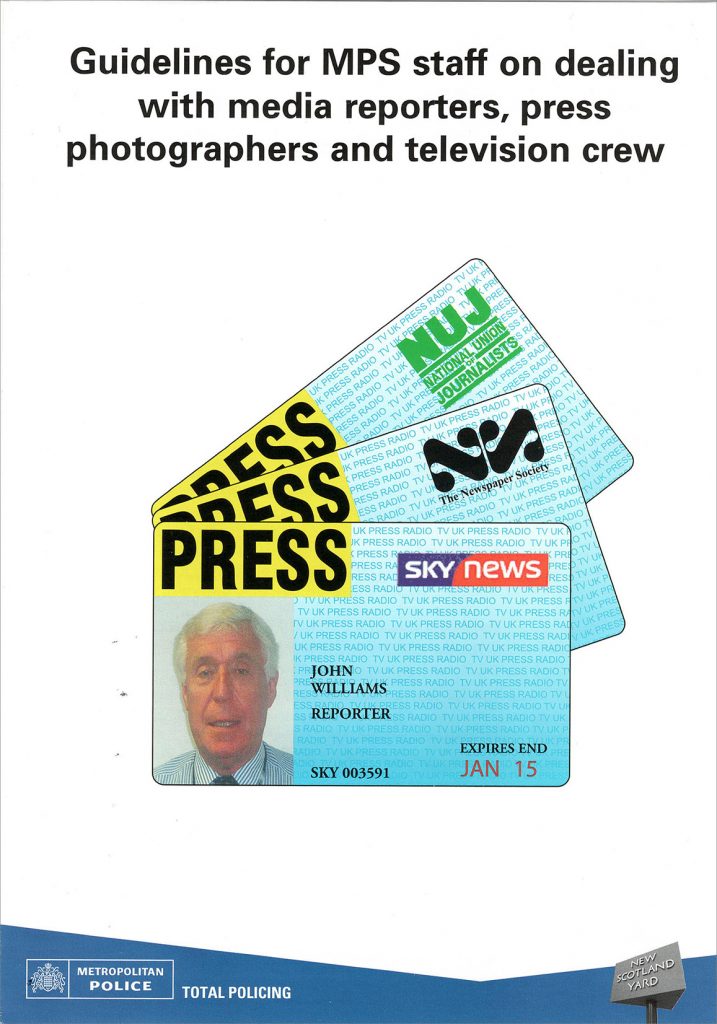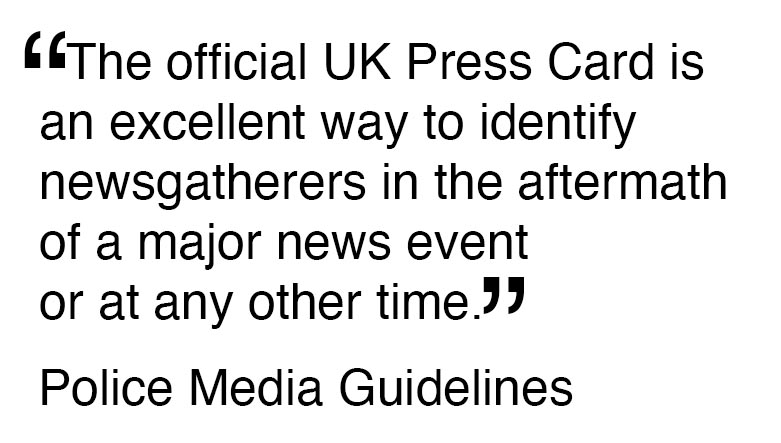Police-Media Guidelines
The following guidelines were first introduced by the Metropolitan Police in March 2006 following two years of negotiations by representatives of a number of the Gatekeeper organisations and the Metropolitan Police at Deputy Assistant Commissioner level. They were later adopted by all police forces in Britain in April 2007 and revised by the National College of Policing in 2016
Guidelines for Metropolitan Police officers and civiliian staff on dealing with media reporters, press photographers and television crews:
‘I believe – and many of you believe – that a key factor in the way we work is how we treat one another and the members of the public with whom we come into contact.’ said Met Commissioner, Sir Ian Blair.
‘We will build trust by listening and responding. Be accessible and approachable. Build relationships. Encourage others to challenge and get involved.’
Our values

Members of the media are not only members of the public; they can influence the way the Metropolitan Police Service is portrayed. It is important that we build good relationships with them, even when the circumstances are difficult. They have a duty to report many of those things that we have to deal with – crime, demonstrations, accidents, major events and incidents. This guide is designed to help you take the appropriate action when you have to deal with members of the media.
Members of the media have a duty to report from the scene of many of the incidents we have to deal with. We should actively help them carry out their responsibilities provided they do not interfere with ours.
Where it is necessary to put cordons in place, it is much better to provide the media with a good vantage point from which they can operate rather than to exclude them, otherwise they may try to get around the cordons and interfere with police operations. Providing an area for members of the media does not exclude them from operating from other areas to which the general public have access.
Members of the media have a duty to take photographs and film incidents and we have no legal power or moral responsibility to prevent or restrict what they record. It is a matter for their editors to control what is published or broadcast, not the police. Once images are recorded, we have no power to delete or confiscate them without a court order, even if we think they contain damaging or useful evidence.
If someone who is distressed or bereaved asks for police to intervene to prevent members of the media filming or photographing them, we may pass on their request but we have no power to prevent or restrict media activity. If they are trespassing on private property, the person who owns or controls the premises may eject them and may ask for your help in preventing a breach of the peace while they do so. The media have their own rules of conduct and complaints procedures if members of the public object.
To help you identify genuine members of the media, they carry identification, which they will produce to you on request. An example of the UK Press Card is shown below.

Members of the media do not need a permit to photograph or film in public places.
To enter private property while accompanying police, the media must obtain permission, which must be recorded, from the person who owns or is in control of the premises. We cannot give or deny permission to members of the media to enter private premises whether the premises are directly involved in the police operation or not. This is a matter between the person who owns or is in control of the premises and the members of the media.
Giving members of the media access to incident scenes is a matter for the Senior Investigating Officer. The gathering of evidence and forensic retrieval make access unlikely in the early stages and this should be explained to members of the media. Requests for access should be passed to the Senior Investigating Officer who should allow access in appropriate cases as soon as practicable.
Advice and assistance in dealing with members of the media is available 24 hours a day via the Press Bureau at New Scotland Yard.
The UK Press Card
All the UK’s professional reporters, photographers, and broadcast crews rely on swift public and official help to bring the news to Britain’s homes and business. And every one of them can get a genuine UK Press Card.

The official UK Press Card is an excellent way to identify newsgatherers in the aftermath of a major news event or at any other time. This is guaranteed by the UKPCA’s gatekeepers, who represent all the organisations which employ or represent Britain’s newsgatherers.
At the core of the scheme is a unique photocard and hotline system managed jointly by the gatekeepers. It has a number of security features and is recognised by the Association of Chief Police Officers for England and Wales (ACPO) and by its sister organisation in Scotland, ACPOS.
Each UK Press Card has a unique serial number. Each cardholder has a separate personal identification number or word. By using the hotline – 0870 8376477 – anybody can verify that the card is genuine and that the holder is a bona fide newsgatherer.
The card also has several secret security features in addition to the verification hotline. There are only revealed to the police or similar authorities. The card is produced using similar technology to the photo driving licence, with the photograph and design integrated into the structure of the card.
Every card carries the logo of the issuing organisation or the holder’s employer together with the holder’s name and the card serial number. And no card can is valid for more than two years, ensuring a periodic review of the holder’s right to have it.
The UK Press Card Authority
The UK Press Card Scheme has been in operation since the early 1990s. It was set up to provide a single, national identity card for professional newsgatherers, following the abolition of a press card issued by the Metropolitan Police Service. It is managed by the UK Press Card Authority Ltd. A list of designated gatekeepers is available on www.ukpresscardauthority.co.uk or through the Press Bureau at New Scotland Yard.
Guidelines for reporters, photographers and news crews for dealing with police at incidents.
These guidelines were agreed at with the Metropolitan Police and adopted by ACPO at the time that the Police Media Guideline were agreed and were published together at that time.
We are the eyes and ears of the public. The role of the police is to act as the law enforcement executive of that same public. It is our role to report on matters of public interest. The police are subject to the same laws as us. This guide has been designed to help you in dealing with the police at the scene of incidents.
1. If asked by officers to identify yourself always be prepared to show your UK Press Card. The police do have a verification line to check this against your press card PIN. It is your responsibility to make sure you know your PIN. It is not necessary to tell police which publication, station or agency you are working for or if you are freelance. However a polite, cheerful conversation goes a long way to promote good relations.
2. If you feel you are being prevented from doing your job in contravention of the police guidelines then show the guidelines to the officer concerned. If this fails to resolve the matter ask to speak to a senior officer or a police press officer if there is one on scene and try to solve any problems that way.
3. If this facility is refused or is unavailable make sure you get the shoulder number of the officer(s) concerned. In the case of senior or plain clothed officers ask for a name and rank. Always remain polite and un-confrontational.
4. With the above information contact your desk or your member organisations liaison officer and seek further help.

